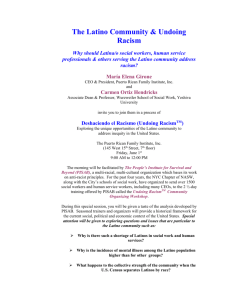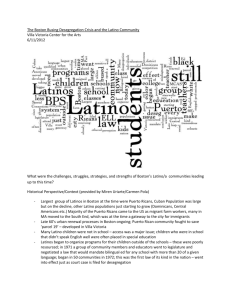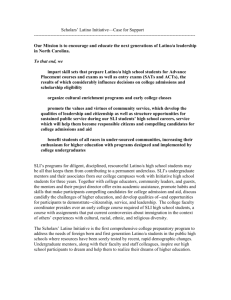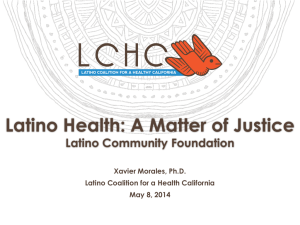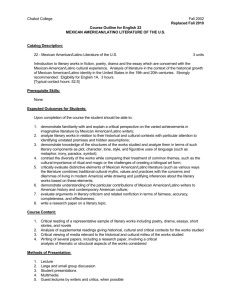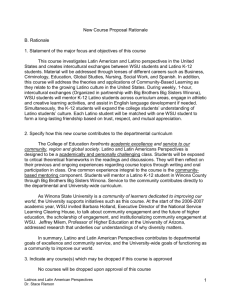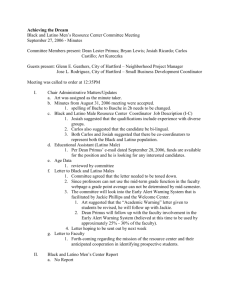American Cultural Studies 314: Contemporary Latino/a Issues
advertisement
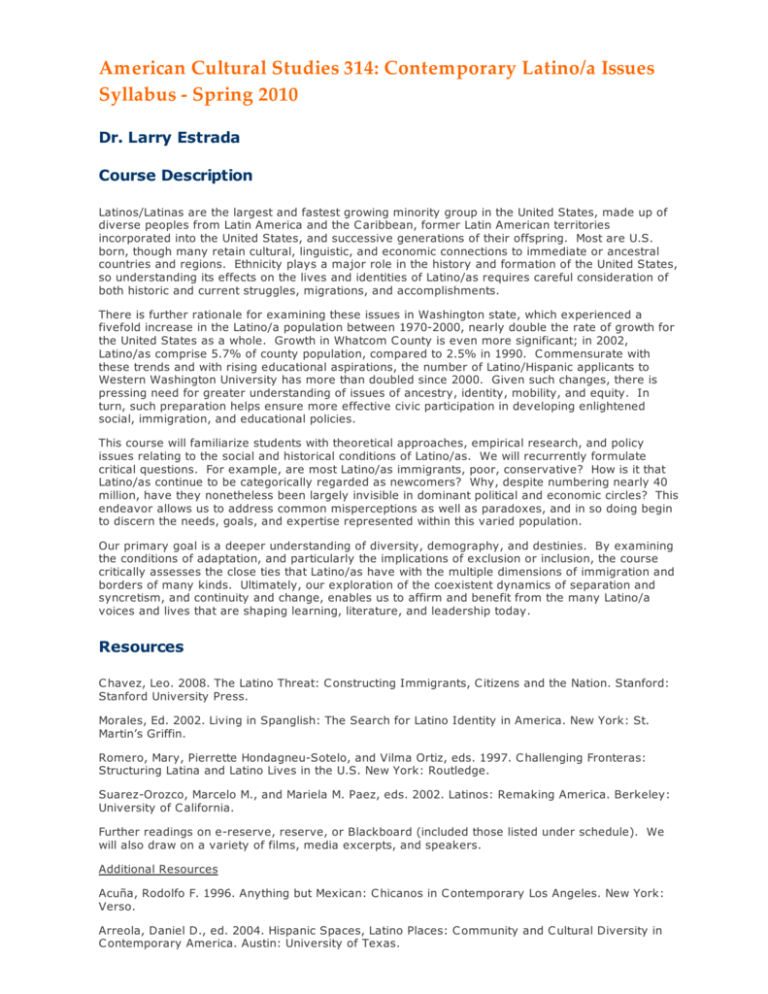
American Cultural Studies 314: Contemporary Latino/a Issues Syllabus - Spring 2010 Dr. Larry Estrada Course Description Latinos/Latinas are the largest and fastest growing minority group in the United States, made up of diverse peoples from Latin America and the C aribbean, former Latin American territories incorporated into the United States, and successive generations of their offspring. Most are U.S. born, though many retain cultural, linguistic, and economic connections to immediate or ancestral countries and regions. Ethnicity plays a major role in the history and formation of the United States, so understanding its effects on the lives and identities of Latino/as requires careful consideration of both historic and current struggles, migrations, and accomplishments. There is further rationale for examining these issues in Washington state, which experienced a fivefold increase in the Latino/a population between 1970-2000, nearly double the rate of growth for the United States as a whole. Growth in Whatcom C ounty is even more significant; in 2002, Latino/as comprise 5.7% of county population, compared to 2.5% in 1990. C ommensurate with these trends and with rising educational aspirations, the number of Latino/Hispanic applicants to Western Washington University has more than doubled since 2000. Given such changes, there is pressing need for greater understanding of issues of ancestry, identity, mobility, and equity. In turn, such preparation helps ensure more effective civic participation in developing enlightened social, immigration, and educational policies. This course will familiarize students with theoretical approaches, empirical research, and policy issues relating to the social and historical conditions of Latino/as. We will recurrently formulate critical questions. For example, are most Latino/as immigrants, poor, conservative? How is it that Latino/as continue to be categorically regarded as newcomers? Why, despite numbering nearly 40 million, have they nonetheless been largely invisible in dominant political and economic circles? This endeavor allows us to address common misperceptions as well as paradoxes, and in so doing begin to discern the needs, goals, and expertise represented within this varied population. Our primary goal is a deeper understanding of diversity, demography, and destinies. By examining the conditions of adaptation, and particularly the implications of exclusion or inclusion, the course critically assesses the close ties that Latino/as have with the multiple dimensions of immigration and borders of many kinds. Ultimately, our exploration of the coexistent dynamics of separation and syncretism, and continuity and change, enables us to affirm and benefit from the many Latino/a voices and lives that are shaping learning, literature, and leadership today. Resources C havez, Leo. 2008. The Latino Threat: C onstructing Immigrants, C itizens and the Nation. Stanford: Stanford University Press. Morales, Ed. 2002. Living in Spanglish: The Search for Latino Identity in America. New York: St. Martin’s Griffin. Romero, Mary, Pierrette Hondagneu-Sotelo, and Vilma Ortiz, eds. 1997. C hallenging Fronteras: Structuring Latina and Latino Lives in the U.S. New York: Routledge. Suarez-Orozco, Marcelo M., and Mariela M. Paez, eds. 2002. Latinos: Remaking America. Berkeley: University of C alifornia. Further readings on e-reserve, reserve, or Blackboard (included those listed under schedule). We will also draw on a variety of films, media excerpts, and speakers. Additional Resources Acuña, Rodolfo F. 1996. Anything but Mexican: C hicanos in C ontemporary Los Angeles. New York: Verso. Arreola, Daniel D., ed. 2004. Hispanic Spaces, Latino Places: C ommunity and C ultural Diversity in C ontemporary America. Austin: University of Texas. Falconi, Jose Luis, et all, eds. 2007. The Other Latinos: C entral and South Americans in the United States. C ambridge: Harvard University. Farr, Marcia. 2006. Rancheros in C hicagoacán. Austin: University of Texas. Garcia, C ristina. ed. 2006. Bordering Fires: The Vintage Book of C ontemporary Mexican and C hicano/a Literature. New York: Vintage. Heyck, Denis Lynn Daly. 1994. Barrios and Borderlands: C ultures of Latinos and Latinas in the United States. New York: Routledge. Loucky, James, and Marilyn Moors, eds. 2000. The Maya Diaspora: Guatemalan Roots, New American Lives. Philadelphia: Temple University. Smith, Robert C ourtney. 2006. Mexican New York. Berkeley: University of C alifornia. Suro, Roberto. 1999. Strangers Among Us: Latino Lives in a C hanging America. New York: Random House. Thompson, Gabriel. 2007. There’s No José Here: Following the Lives of Mexican Immigrants. New York: Nation Books. Class Dynamics and Assignments As far as possible, we will use an empirical approach to examine the issues we address. Some ideas and information may be disconcerting, and every effort will be made to encourage tolerance as well as openness to different perspectives and experiences. A dynamic class also requires commitment of all participants, evidenced through engaged participation, respectful listening, active individual and group research, and consistent attendance. Everyone has the opportunity and obligation to fully engage all learning exercises, to ask probing questions, and to integrate readings into class discussions. Participation: 20% Active participation includes: contributing to discussion, posing critical questions from readings, sharing resources (including from alternative and dominant media), and consistent attendance (no more than two absences). Reflective Writing: 30% Three short (250-300 word) reflection essays will enable students to probe and personalize issues considered through readings and class discussions. Policy research: 30% Students will engage in two pilot research exercises, and are encouraged to work in pairs to do this. First, you will consider a current ethnography or case study (for example, under “Additional resources”), focusing on the characteristics and challenges of an emerging or maturing Latino/a community. Second, investigate a contemporary controversy – for example, dual citizenship, racialization of incarceration or financial lending practices, bilingualism, border securitization, and so forth. Results of both research endeavors will be presented as part of a lesson to the class, as well as through a written research paper. You may do this individually or as coauthored collaboration, either co-authored or with introduction and conclusions/implications that enclose related individual research papers. Extending learning beyond the classroom: 20% Each student is responsible for seeking ways to extend our learning beyond academics. This can occur by exploring how our readings are reflected locally, seeking out people to interview, contributing to curriculum development/dissemination, engaging in an internship, and community involvement or volunteering (eg, C ommunity to C ommunity; Sea Mar; MEC hA). Weekly Course Schedule (in addition to selected readings, text assignments TBA) Week 1 - Introduction roots of diversity – of culture, identity, political power Latinization of the United States statistics and stereotypes, nomenclature and nuances reading: Arreola, Daniel D. Montero-Sieburth, Martha, and Edwin Meléndez. 2007. “The C hanging Demographics of Latinos” and “The New Nativism and Latinos in a C hanging Society.” In Latinos in a C hanging Society. Montero-Sieburth, Martha, and Edwin Meléndez, eds. Westport C T: Praeger. Week 2 – Here, There, Everywhere continuing importance of national origins and multiple identities Latin American legacies: indigenous, Iberian, international films: “A C hinese Writes to the Aztecs”; “Through Mexican Eyes” reading: (excerpts) Rodriguez, Gregory. 2007. Mongrels, Bastards, Orphans, and Vagabonds: Mexican Immigration and the Future of Race in America. New York: Random House. Week 3 - Politics of Ethnicity Latino, Latina; Xican@; Mexican-American… generational differences – mobility, education, identity reading: (selections) Latin American Perspectives. 2006. The Politics of Ethnic C onstruction: Hispanic, C hicano, Latino…? Thematic issue: 19(4). Reflection paper #1: “What is Latino?” (note that the question is not “who”) Week 4 - Attitudes, Actions, and Reactions a history of inclusion and exclusion prejudice, racism and discrimination racial/ethnic/linguistic categories & implications for social and political mobility reading: Lovato, Roberto. 2007. “No Laughing Matter: Anti-Latino Humor has Entered the Mainstream.” The Progressive 71(11):38-39. Week 5 – Hypenated Americans, Hybrid C ultures? Mexican Americans – the oldest and largest community rooted in annexation, renewed through migration C entral Americans, C aribbean Americans, South Americans reading: Rivera, Gaspar. 2004. “Introduction” and “C onclusion.” In Mexican Indigenous Migrants in the United States. San Diego: C enter for Mexico-US Relations. Reflection paper #2: Dilemmas of diversity (draw on “Ask a Mexican,” Gustavo Arellano’s weekly column in the Orange C ounty Register). Week 6 - Borderblur what/whose border? - the border crossed us how migration and immigration shape Latino/a realities and futures transnational dynamics reading: Waldinger, Roger. 2007. “Between Here and There: How Attached are Latino Immigrants to their Native C ountry?” Pew Hispanic C enter, Report - October 25 Report. Week 7 – Opportunities and C hallenges from immigrants to ethnic communities political participation, professions, prospects reading: Zlolinski, C hristian. 2008. "Political Mobilization and Activism among Latinos/as in the United States." In Latino/a Sourcebook; H. Rodríguez, R. Saenz and C . Menjívar, eds. New York: Springer. Reflection paper #3: “Más que solo una fiesta…” (Probe what you learned through participation in, and further investigation of, C inco de Mayo events on campus and off) Week 8 – The Power of Time and Place generations shaping their futures empowerment: past and present policies vs. current cultural and intellectual resources reading: Tienda, Marta, and Faith Mitchell. 2006. “Uncertain Destinies.” Pp. 115-127. In Multiple Origins, Uncertain Destinies: Hispanics and the American Future. Washington: National Research C ouncil. Research report: investigate and report on key insights into an emerging or maturing Latino/a community, drawing on a recent ethnography or case studies (Add. resources). Week 9 – Education: Preschool to Post-graduate historical, cultural, and sociopolitical dimensions of schooling experience (dis)continuities between home and school promoting academic repertoires: contributions of social structure & cultural participation reading: Pedraza, Silvia. 2000. "Beyond Black and White: Latinos and Social Science Research on Immigration, Race and Ethnicity in America." Social Science History 24: 697-726. Week 10 – Where We are From, Where We are Going student research/advocacy projects/presentations Printer Friendly Version © 2006, C enter for Instructional Innovation and Assessment



